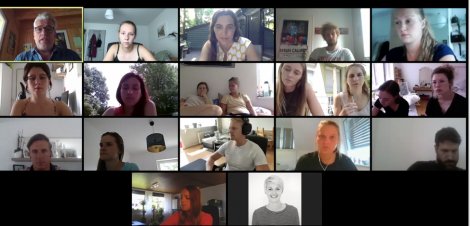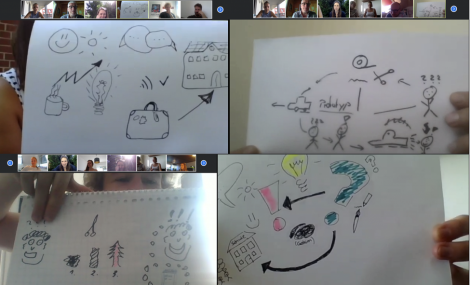Thinking Inside the Box: Design Thinking in Zoom Conference Mode

Teaching scenario shoe box models of classroom setups in vocational schools
Tinkering, making, participatory design, design thinking – I love creative and haptic approaches to teaching, learning and web development. Over the past two years, I have been traveling back to Germany on several occasions to teach or co-teach classes using design thinking. One of my favorite places to facilitate these workshops has been the Innovation Lab at Münster University of Applied Sciences (FH Münster). The flexible furniture, the equipment, the ability to fill a room with student artifacts throughout the workshop days, all of this makes a great setting for interaction and deliberation of ideas.
Why travel though: As an edtech specialist, can’t you do a design thinking workshop virtually? If you had asked me before COVID-19 turned education topsy turtle, my answer would have been categorically ‘no’.
In collaboration with Thilo Harth, professor of education at FH Münster, and an expert on vocational training, I conducted a series of student-centered in-person workshops in 2018 and 2019. In 2020 I found myself in a Zoom room across the Atlantic attempting to co-moderate a design thinking class that was taking place fully online in a different time zone.
How did it happen, why did we do it and how did it go?
How Did It Happen?
We had planned for both a vocational teacher candidate education class and a faculty workshop or mini-conference on design thinking at Münster University of Applied Sciences for several months. Long before COVID-19, corona and social distancing were part of our everyday vocabulary we received funding, and planned dates, times and topics. Boosted by past successes, we were eager to expand our design thinking research and practice. At last year’s (last ever) E-Learn conference, Thilo and I received a best paper award for our work on ‘Creating Effective Physical Learning Spaces in the Digital Age – Results of a Student-Centered Design Thinking Workshop’. Awards are great to advocate for a topic, and increase visibility.
What’s more though, a few months later we received an email from a student who participated in the class that we described and analyzed in our paper. It was a couple of pages long. For the purpose of this post I translated an excerpt.
This is Sarah-Lena:
The experience I gained in the design thinking class has had long-lasting impact. During my recent internship I served at a huge vocational school over the course of five months. The school had over 3000 students and almost 200 teachers. Armed with spaghetti and marshmallows, I had absolutely outstanding experiences with the students in the various courses.
The students did not take advantage of the unconventionally open structure, as the seasoned teachers had predicted. Instead, they developed their results in both emotional and constructive discussions. This led to a culture shift that teachers in other subjects noticed. They asked me what I had done. Before, classes shifted between lethargic and aggressive and it was not possible to work. Teaching was a struggle and at least one of student had to leave the room every hour. The activities changed student attitudes.
In the course of the typical session, soda bottles flew across the room and the active participation concentrated chiefly on students having conversations among themselves about the weekend. Students were initially hesitant about the Marshmallow Challenge. Within moments, they were hooked. In a subsequent series of lessons that incorporated design thinking elements we discussed what school is good for. This culminated in an open letter the students wrote to their teachers.
Why did We Do It?
To me, Sarah-Lena’s email was humbling: I am far from certain whether I would have dared to do what this young teacher candidate did, let alone succeed. When I expressed as much, she simply told me ‘When you taught us about the concept of ‘fail-fast’ it made me absolutely fearless. It’s totally okay to fail, evaluate and iterate’.
Well then, time to learn from our students. When it became apparent that not only international travel but also in-person classes were out of the question for the foreseeable forever, it seemed we had a choice. Fail fast or chicken out.
How did it go?
A total of 17 students in the master program ‘vocational education’ participated in the workshop. The group comprised diverse subject matter backgrounds and varied levels of prior professional experience. Some students had previous experiences with design thinking, others were new to the approach. The design thinking workshop was preceded by five class dates that discussed how teaching and learning in vocational education needs to respond to and reflect on the volatility, uncertainty, complexity and ambiguity (VUCA) of its societal surroundings.
The two-day workshop took place on a Friday and Saturday, end of June 2020. Picture the weather as warm and sunny. In both Münster, Germany and Chapel Hill, NC the outsides were tempting and lured with activities other than Zoom calls. Separated by the time difference of six hours and over four thousand miles apart, we connected in the virtual setup of the workshop.

To my amazement, it worked! While it’s not the same, and it’s not a substitute, as a class we had fun, we connected, and it was one of the most enjoyable Zoom sessions I have had over the past months. We leveraged breakout rooms with different group setups and sizes. Students co-created, presented and discussed results through a set of exercises:
- Sketchnoting: Sketchnoting, sometimes also called graphic recording or visual notetaking, is a method of notetaking that incorporates hand-drawn visual elements. To open up the workshop, participants created a sketch of their expectations of the first two days of class.
- Personas: Personas are a narrative storytelling technique for bringing abstract target group information to life through the presence of a specific, fictional personality. Personas aid in identifying needs and possible behavioral patterns and are typically generated based on either demographic information or interview data. The students were tasked with creating personas of vactional education students for their subject area.
- Customer Journey Maps: Customer Journey Maps document the locations and settings where people interact with an organization or service. Mapping these touch points in form of a timeline visualizations or narration allows to identify effective ways of changing interactions between individuals, groups and organization. To learn how to use this too, the students created maps of their remote learning environment. We discussed shared frustrations, and cherished aspects of campus life, and discovered patterns across different groups.
- Shoebox models In a combination of rapid prototyping process and think-pair-share exercises students developed teaching and learning scenarios to reach the personas for specific learning goals. The students were grouped across subject specializations to offer a fresh perspective.

Zoom room with sketchnoting
In the classroom scenarios, it was really interesting to see how much attention the students paid to physical space. Almost every teaching scenario they developed had learners move around the room, and purposefully designed sections of the classroom such as a question bar, a presentation space, an investigation hub, etc.
For the purpose of evaluating the learning experience and closing out the workshop, we leveraged padlet. Students were able to post and comment anonymously. The feedback was highly valuable for understanding the possibilities and limitations of web meetings for highly interactive classes. Our facilitation was far from perfect– we learned several critical lessons. Our takeaways are chiefly centered around discussion and orchestration of tasks.
- Orchestration of tasks: Our facilitation was far from perfect. Whereas groupings are effortless and time management can be flexible and based on observation of the groups in a face-t-face setting, these tasks were tedious and less flexible in the digital environment. We faced several breakout-room problems. Assignment issue occur when students are late, when participants are missing or when unexpectedly additional participants attend.
- Discussion: One of the main reasons why students like design thinking is that these workshops allow them to be innovators whose expertise is taken seriously. One point of criticism we took very seriously was the lack of student-centered discussions. It’s much harder to read a room on the screen, and facilitators are easily led to fill gaps of silence.

Screenshot: Padlet Discussion Board
What’s the verdict? Students definitely encouraged us to keep experimenting with the virtual workshop format. Given the choice, I would certainly prefer physical co-presence. However, based on the unclear path forward for in-person teaching at universities, we may very well be doing more design thinking activities in an online environment.
Acknowledgements: This post describes a course concept developed at Münster University of Applied Sciences in the context of the the teaching innovation project, ‘Wandel bewegt’ (Change Moves) by the ‘Wandelwerk FH Münster’. This project is funded by the German Federal Ministry of Education and Research from 2012 to 2020 with 15 million to act as a catalyst for change in the teaching and learning culture on this regional campus. One result of the project is the ‘Co Creation Lab’, both an example for innovative learning spaces and a petri dish for ideas that allows teachers and students to experiment with transformative learning concepts.

kronologibayu
December 22, 2021 at 12:45 pm
I learned new information from your article.
thank you very much.